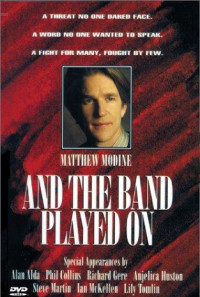3.8
5
The story of the discovery of the AIDS epidemic and the political infighting of the scientific community hampering the early fight with it.
- DIRECTOR
-
- Roger Spottiswoode
- WRITERS
-
- Randy Shilts
- Arnold Schulman
- STUDIOS
-
- HBO Pictures
- Spelling Entertainment
The early years of the AIDS crisis in the United States is presented. The multi-layered story centers on efforts at the Centers for Disease Control (CDC) in Atlanta to identify the cause and transmission of and thus fight the disease. Many of the internal battles at the CDC are between Dr. Don Francis, the idealistic young lead investigator, whose thoughts of seeing mass deaths in other epidemics is never far from the front of his mind, and his boss, Dr. Jim Curran, who feels that they have to work within the meager funding supplied by the federal government and be politically correct to further the long term work more effectively. Many of their external battles are with the Republican led federal government, who woefully fund their work, and with other organizations, such as blood suppliers, who are initially unwilling to test their blood supply using an expensive hepatitis B surrogate test in the absence of a known AIDS test, or disclose blood donor information for their potential AIDS transmission probability (i.e. gay men). A second facet of the story centers on the gay community in San Francisco, and the balancing act gay advocates and public health officials in the city have to do to protect the gay population from what is largely seen initially as a gay disease, yet not further stigmatize and suppress an already largely stigmatized and suppressed gay population in the US. A third facet of the story centers on the work by academics to identify what many believe is a retrovirus cause of the disease. Two of the teams working largely in isolation are led by Dr. Luc Montagnier at the Pasteur Institute in Paris, France, and Dr. Robert Gallo at the National Institutes of Health in Bethesda, Maryland. Dr. Gallo's motivation as being seen as *the* one and only scientist making significant contributions to the field, and only when working on AIDS research is seen as being fashionable, as opposed to the motivation of public health, has the potential to stall the effective treatment of the disease for those infected. Through these three facets, personal stories of individual AIDS victims are presented, at that early stage where there is a 100% mortality rate.
SIMILAR MOVIES
-
My Invisible Friend

2010 •15 min -
Erotic Survivor

2001 •97 min -
Foley Artist

2013 •18 min -
The Immigrant

1917 •30 min
























